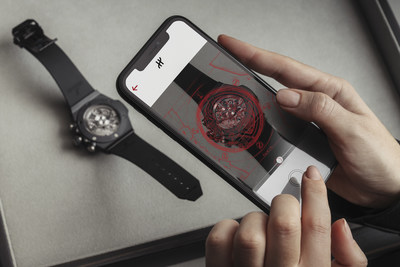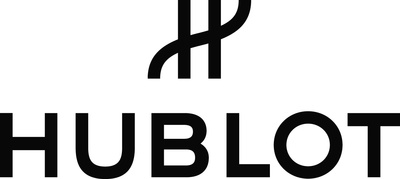The authenticity of Hublot watches is guaranteed by a visual recognition of the micro-structure of their materials.
With the HUBLOT e-warranty, Hublot is launching a completely digital warranty stored in the AURA blockchain.
To stay up-to-date, follow: @Hublot #Hublot
“After being one of the first companies in the world to equip its watches with an electronic warranty in 2009, Hublot is once again innovating with the Hublot e-warranty. Hublot will use an electronic passport and warranty system, much like facial recognition, based on the uniqueness of the materials that make up its watches. This advanced technology required more than three years of research and development in partnership with the company KerQuest. Today, thanks to the Hublot e-warranty, a simple photo taken with a mobile phone is all it takes to activate the warranty and access it, while verifying the authenticity of the product. Although the technology developed relies on complex algorithms, it is simple and user friendly. A perfect fusion between technological complexity and ease of use.” Ricardo Guadalupe, CEO of Hublot

With the Hublot e-warranty, Hublot & KerQuest are fusing materials and ground-breaking algorithmics to revolutionise the user experience. The watch is thus authenticated by the recognition of the specificity of its materials. A first in the fight against counterfeiting.
Gone are the days of warranty cards and authenticity certificates; with its new Hublot e-warranty protection and warranty system, the watchmaking Manufacture is simplifying the tracking and tracing of its watches, from their manufacture through to customers, via points of sale. Faithful to its motto “Be first, unique, and different”, the watchmaker, with the Hublot e-warranty, has created a technological first in which the watch itself becomes the key to open up a new world of services. As well as facilitating use for points of sale, customers and customs alike, Hublot is improving the prevention of counterfeiting and theft. Simple, easy and effective!
The watchmaker has been working on the development of algorithms in partnership with the company KerQuest since 2017. The goal was to develop a technology that relied on the very recognition of the specificity of the watch, namely the microstructure of the materials that make it up. This way of working seemed obvious to the master of the Art of Fusion, which has been using materials and their fusion to differentiate itself for 40 years. As an additional challenge, although the recognition of a material in the broadest sense has been studied for several years, its actual unitary recognition was what had been problematic until now. With the evolution of smartphones and in particular the improvement in camera definition, as well as the development of artificial intelligence, Hublot and KerQuest were able to perfect the first visual recognition of a watch.
Each and every Hublot watch is unique: even two watches of the same model leaving the manufacture are distinguishable thanks to the singularities of their microstructure. The challenge faced was how to read them and process them in a reliable and practical way. The Hublot e-warranty is based on the unitary recognition of the specificities of all of Hublot’s watches and models.
The main technology is found at the very heart of the manufacture, where, in a way, the passport of the watch is established. Specially designed optical readers image and reconstruct the reality of each piece in full detail, in very high definition. Every watch is indeed “photographed” as it comes out of production. When the watch is sold in a boutique, the point of sale activates the warranty using the Hublot-e-warranty application (which takes a photo of the head of the watch lined up with a duplicate displayed on the screen). The photo is sent to the computing infrastructure that will process it and automatically activate the warranty if the piece has been correctly identified unitarily. Once the watch has been recognised and authenticated, the customer receives their Hublot e-warranty via the channel of their choice (SMS, E-mail, WhatsApp, WeChat, Instagram, Messenger, etc.), and will then easily be able to join the Hublotista community.
A specific e-warranty application also exists for customers. This enables them to easily access new services, such as verifying the authenticity of a piece, retrieving the warranty status of a piece, or accessing the Hublotista community. In the event of the loss of warranty data or of the sale of the watch without transferring the warranty to the new owner, the unitary recognition of the piece by the Hublot e-warranty application, available on the Google Play Store and Apple App, once again enables access to all the information about the watch and its warranty. During a transaction involving a second-hand watch, the Hublot e-warranty application will enable the seller or buyer to check the status of the piece, and will protect the seller from the resale of a stolen watch.
The Hublot e-warranty technology is already compatible with all the pieces produced by the Manufacture since the start of 2020. This fully functional technology is currently being rolled out across all Hublot points of sale. The pioneering Paris Vendôme boutique, which has been equipped for over a year, and the Swiss boutiques and retailers are also already operational. The other markets will follow in the coming months. For earlier pieces, the electronic warranty card remains in place. When these watches are next with the after-sales service, they will be recorded by the Manufacture so they can benefit from the new Hublot e-warranty system.
Once again, Hublot is placing the customer experience at the heart of its developments and intends to leverage this technology to offer its loyal customers new interactive features.
Already first in 2009 with the electronic warranty card
In 2009, Hublot became one of the first companies in the world to equip its watches with the WISeKey technology—a warranty card activated on purchase, working with a two-factor authentication system (cryptographic key and watch serial number). This technology was combined with a USB warranty reader and already enabled the customer to join the Hublotista community. In 2015, it evolved, replacing the contact electronic chip with NFC (near field communication) technology.
The Hublot e-warranty will be part of the AURA blockchain initiated by LVMH
The new warranty system developed by Hublot is part of a global trend to fight counterfeiting and to track and trace product lifecycles, initiated by LVMH. The Hublot e-warranty will be stored in the AURA blockchain, intended for use by other luxury brands. Developed by Microsoft and the blockchain company ConsenSys, AURA is the first international blockchain designed to help consumers trace items and assess their authenticity. Designed by and for luxury brands, it enables the tracking of raw material sourcing and the protection of intellectual and creative property, among other things.

